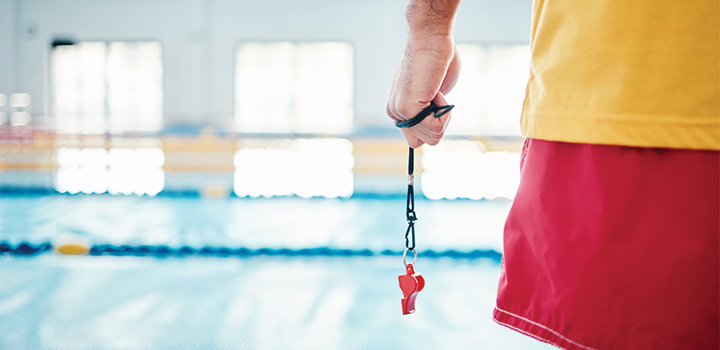The possibility of accidents cannot be eliminated, but they can be prevented and adequately prepared for.
One way to manage that risk specifically in aquatics is through your lifeguards. At Oklahoma State University (OSU), properly certified staff are constantly vigilant for anything that could pose a risk. They have routine checks of the physical space for hazards like sharp edges, slippery spots, blind spots, etc., along with checking the pool’s chemical levels. According to Matt Beck, the associate director of the Wellness Program, these are the most common risks at OSU, so getting ahead of them is vital.
“It’s important to ensure a culture of safety along with maintaining a safe physical environment,” said Beck. “One cannot cut corners on safety trainings or precautions. Train staff’s skills often.”
At Portland State University (PSU), lifeguards are the only position within campus rec whose main priority is safety and emergency response. Todd Bauch, the associate director of Operations and Student Development, gave the example of a belaying climbing instructor compared to a lifeguard. Since an instructor and a climber are attached by ropes, the participant can activate a safety system. But a swimmer has to rely on the response and expertise of the lifeguard.
EXTRA CREDIT: Overcoming lifeguard shortages.
Along with crisis preparedness, PSU lifeguards are trained to recognize and prevent a specific, common hazard: the lack of the ability to swim. In this case, lifeguards can require a person to demonstrate their swimming skills or that they stay in the shallow end of the pool.
With an important responsibility and high expectations, taking care of aquatics staff both professionally and personally is important.
“Staff have to be well-trained and practiced,” said Bauch. “This is somewhat built into the traditions of the industry with common practices like initial certifications, monthly safety in-services, renewal processes, head guards and skills audits. More importantly, we need to take care of them as people. We must help them through the inter-personal strife that challenges can create. They must be able to work together and rely on each other.”
Another piece of advice was to remain cognizant of staffing problems and trends within the industry.
“Hire more people than you think you’ll need,” advised Bauch. “Students will work less hours as the term goes on due to academics and illness. A problem in aquatics is the shortage of lifeguards and swim instructors, and there is currently a wage war for lifeguards. They will leave your facility to chase money offered to them. Because of these shortages and assumed job security, lifeguards can develop bad habits they get away with because their peers don’t correct or report them.”
EXTRA CREDIT: Aquatics safety best practices.
For Shelby Wood, the Aquatics coordinator at the University of South Carolina, having excellent lifeguards starts with the hiring process.
“Seek out students who already understand and respect the importance of risk management,” said Wood. “I have found I can train almost anyone on specific lifesaving skills or help them acquire any certification. However, I cannot teach them how to be passionate about saving someone’s life.”
Another challenge Wood mentioned was figuring out ways to keep students engaged with trainings. A strategy that has helped is getting students involved in facilitation.
Wood oversees a group of student managers who help plan and lead trainings. Doing so benefits the managers who gain important professional skills, the trainees who receive the information more effectively and Wood who gains a better understanding of student staff’s needs.
Another way to further engage student staff during training is by making them fun. Wood has led creative workshops that prove more effective than long presentations or demonstrations. One example was creating biohazard waste with miscellaneous food items to teach bloodborne pathogen/bodily fluid cleanup.
EXTRA CREDIT: Four factors to consider when developing a plan for risk management at aquatics facilities.
“The more out-of-the-box thinking you can get with your trainings, the better,” said Wood. “As aquatics practitioners, we commonly gravitate toward our textbooks or manuals for training materials. We need to consider our employee demographic to help foster an age-appropriate and exciting training environment.”
Being prepared for emergencies or dangerous situations goes hand-in-hand with preventing them. Hopefully, lifeguards will never need to use the skills they learn, and the preventative measures they take keep risks at a minimum.
“I focus on equipping my students with as many tools as possible,” said Wood. “They just have to be able to use them. Most, if not all, of our facility rules are aimed at preventing risks. For example, we don’t allow patrons to use our sauna for extended periods of time. Our lifeguards check it every 20 minutes to ensure no one is experiencing heat exhaustion. Rules like this help protect people from common risks.”
Overall, investing in your lifeguards is the biggest way you can manage risk around the pool. Meeting their needs must be balanced with your standards of excellence. By finding that middle ground, the pool will be a safe and fun space.










